On my recent trip to Finnmark I had to skip out on a couple of days of hiking because the weather was really bad. On one of those days I was sitting in a cosy café chatting to the owner and when I told him what my plans had been for the day before it started snowing (yes, in June) he suddenly got all serious and said “well I’m SO glad you didn’t try to hike today.”
And I had to laugh, because he was sporting the same stern expression I do when I talk about hiking in Norway. Hiking here is no joke, and you will probably never see me more serious than when I am talking about the importance of preparing properly and respecting Norway’s magnificent, but also at times very dangerous nature.
My heart breaks every time I hear about a hiking accident here, especially as the more serious accidents usually happen to foreign tourists and could have been avoided if they had known just a bit more about hiking in Norway.
Don’t get me wrong, hiking in Norway can be the experience of a lifetime and I certainly don’t think you should miss out on it, but I do think that you should do your research first. And at the very least, try to avoid these (all too common) mistakes:
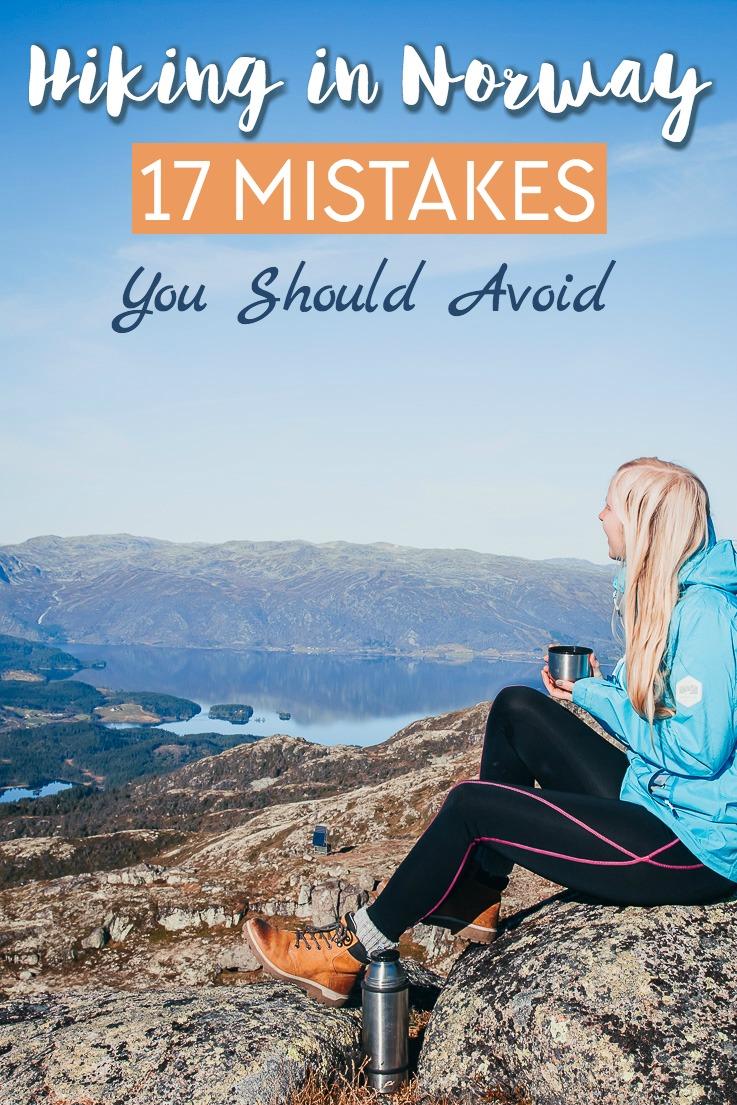
I’ve gathered all my best advice for planning an incredible trip through southern Norway (from the far south up to Trondheim) in a 93-page ebook covering my top recommendations for places to visit (both on and off the beaten path), the best times of year to visit, how long to visit for, the best accommodation choices, transportation, what to eat, what to pack, and a sample itinerary that covers my personal favorite route through the south.
Hiking in Norway without the right footwear
This is number one on the list for a reason – proper footwear is so important on a hike. Because while you’ll be fine in sneakers on a shorter walk, most hikes in Norway really require waterproof hiking boots with proper ankle support. You’ll have a hard time getting home on a sprained ankle!
And if you’re tight on luggage space, I would actually just bring hiking boots instead of sneakers – at least I wear my hiking boots everywhere. In fact on my trip through Northern Norway I only had my hiking boots with me. Just be sure they’re broken in first!
It’s funny, every visitor I’ve had in Norway has brought several pairs of shoes with them, and whether they’re visiting Norway in the summer or the winter, they always just end up wearing their boots here. Norwegian fashion is pretty laidback and a lot of people just wear boots here, because that means it’s easy to go on the spontaneous wander through nature (and really, isn’t that why you’re in Norway in the first place), plus boots hold up so much better against our ever changing weather in Norway.
One moment it might be sunny, but we know it’s about to start raining again, and with boots on we’re ready for it.
I have these hiking boots, which I love because they’re waterproof and super supportive, but they also don’t look too sporty to wear walking around a city in a sundress.
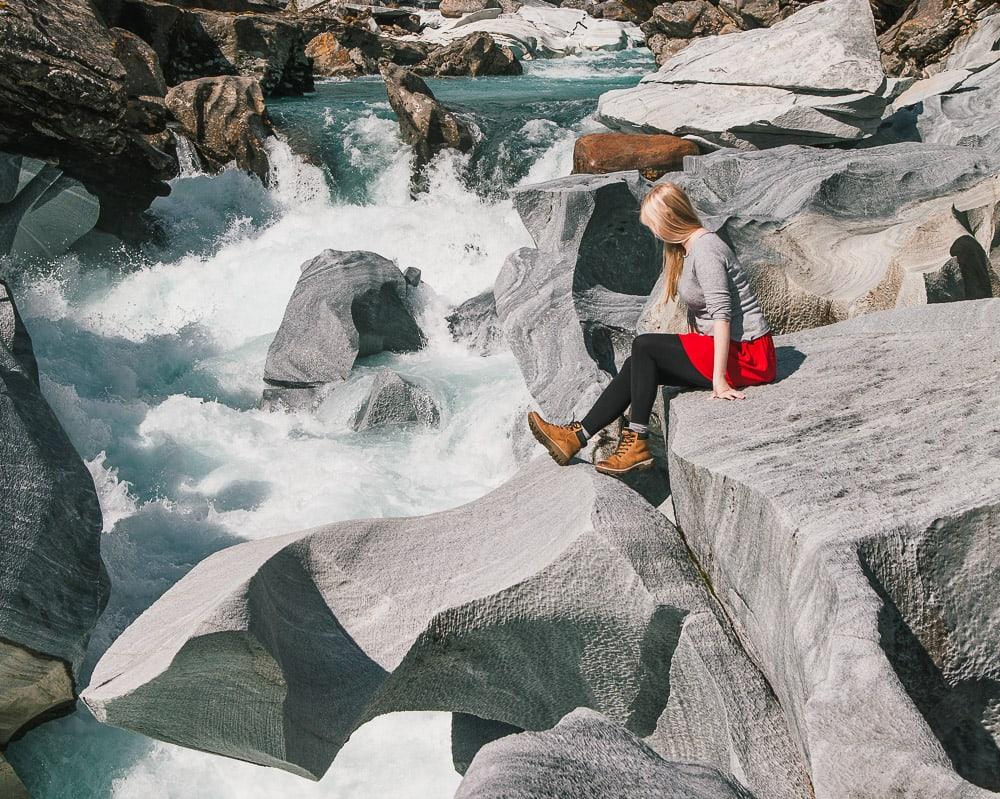
Wearing jeans
I always thought this commonly shared warning was a bit of a joke until a few weeks ago I came across a couple hiking in jeans – in the rain. Uh, don’t do that.
Ideally you’ll want to invest in some quick dry hiking trousers. As an added bonus, Norwegians love these trousers so you’ll totally look like a local! You could even buy some hiking trousers at a local sports shop to have as a nice souvenir from Norway.
Though just be aware that while on Amazon you can usually find good quality hiking trousers for around $40 – $50, in Norway they’ll be at least $100. So if you want to save money, bring them with you.
Wearing only one layer of clothing
If you read my packing list for summer in Norway you’ll already know that the key to dressing for Norway is layers – if you’re not wearing them, bring them.
The weather in Norway can change in an instant, and the temperature changes as you go up in altitude can be dramatic. I’ve started off hikes in summer shorts weather and found myself in a snowstorm.
Wear a thermal inner layer – wool is best because it will keep you warm even if you get wet – bring a warm sweater or fleece, and have a water resistant jacket with you in case the weather turns. I also always bring a hat with me because the wind at the top of mountains can be brutal.
It’s going to feel ridiculous packing winter sweaters for a summer trip to Norway, but as hard as it might be to imagine actually wearing them, you will. And you will be so happy you had the foresight to bring warm clothes with you!
Ignoring the weather
Norwegians have a saying “there’s no such thing as bad weather, just bad clothing.” And it’s often true. You can totally still go on a hike in the rain or extreme cold if you have the right gear.
But then again, sometimes there is such thing as bad weather, and in those cases unfortunately you might have to cancel your hike.
If there’s a hike you have your heart set on then try to factor in at least two days in that destination to give yourself the best chance of being able to do it. But also be prepared for disappointment, because no hike is worth risking your life for in stormy weather.
I can’t tell you how many horror stories I’ve heard of tourists persisting with a really difficult hike even if the weather is horrible. Hikes in Norway are already quite difficult – if a Norwegian tells you a hike is “easy,” that means medium/hard difficulty to the rest of us. No joke!
The landscape here is also made up largely of huge rocks and moss, which make for a very slippery combination when wet. I know you want that epic shot on top of the mountain but please, don’t risk your life to get it.
Not consulting locals
It can often be hard to find updated information about hikes online, especially in English, so you’re always best off consulting with locals about any bigger hikes you’ll be attempting. Stop in the local tourist information office, or simply ask someone at your accommodation.
Norwegians are incredibly passionate about hiking and they will be SO happy you decided to consult with them. Not only do they simply really enjoy talking about hikes and recommending their favorite hikes to people, but Norwegians also really want visitors here to have a positive and safe experience, so they’ll appreciate that you took the time to get information from them about the hikes you’ll be attempting.
And if you’re feeling unsure about your hike, see if it’s possible to go with a local guide. Not only will this ensure your safety, but you’ll get the chance to spend the day with a local and learn a lot more about Norway. Usually the tourist office can help arrange this, or I know Viator has a lot of guided hikes you can book online.
It may seem like a touristy thing to do, but actually all of the best hikes I’ve gone on in Norway have been with guides. They’ve been able to show me their favorite spots, they know where you should stop to take photos (isn’t it the worst when you miss a photo opportunity because you mistakenly think there will be a better spot up ahead?), and there’s no better way to bond with Norwegians than on a hike out in nature. Seriously! If you want to get to know Norwegians, go hiking with them.
Trying to plan your Norwegian hike online
I get emails every week from people asking where the best hikes are in places in Norway I’ve never blogged about (so presumably have never been). And I totally get the desire to plan out your trip before arriving in Norway, and I totally appreciate you doing research online – I mean hello, you’re here reading this now! – but in this case it’s actually so much better to wait to ask locals about the best hikes.
Because even if you can find information online, usually it will just be for the super popular, super touristy hikes, whereas only locals will know about the hidden gems. So like I said before, stop in the local tourist information office or ask at your accommodation.
And guys, while yes those popular, touristy hikes might look amazing on Instagram, they really aren’t as great in person. They’ll be busy and often the trail will be worn down, and if you’re hiking with crowds of other people you’re really not getting the authentic Norwegian hiking experience.
Like, locals sometimes joke how it’s nice that tourists only stick to the same four hikes in Norway because it means the rest of the hikes are empty, but I find it a little sad that those tourists are missing out on much better experiences just because they only knew about the famous hikes here.
And don’t worry about not having a firm plan in advance – there are so many hikes all over Norway (even in the big cities) that you’ll be sure to find something that suits your timeframe and fitness level, as well as the local conditions.
But if you do really want to try to plan out your Norway hikes in advance, Ut.no has all of the hiking trails in Norway marked on a map here, including both the summer and winter trails (winter trails are usually for cross-country skiing). The website is unfortunately only in Norwegian, however Google Translate should at least help you to get a rough idea of the hikes. Plus a map is a map, regardless of the language, right?
Setting off on a hike without telling anyone
It might seem unnecessary, but please be on the safe side and tell someone where you’re going, just in case something happens. You could tell your hotel reception, message a friend, even tweet about setting off on an exciting hike in Norway – just tell someone.
You never know what could happen, even on a short hike, plus who doesn’t want the chance to brag about getting to explore this beautiful country?
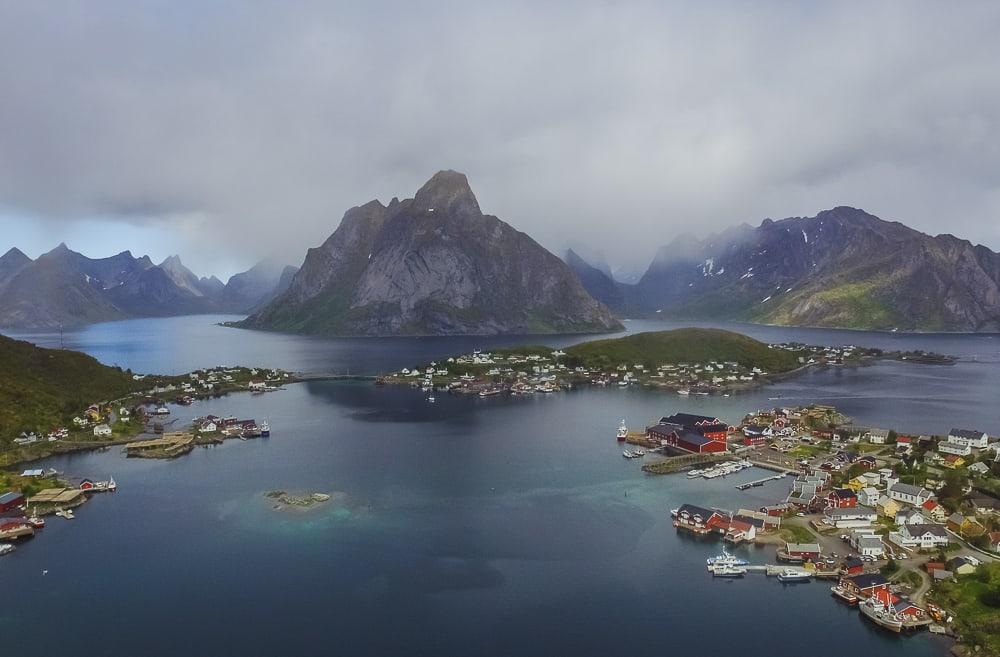
Starting too late
While daylight isn’t an issue in the height of summer, during the rest of the year you do have to carefully time your hikes to make sure that you can get home before it gets dark. Factor in lots of extra time for breaks and getting lost, because you definitely don’t want to get stuck somewhere in the dark.
And it’s the worst feeling when you have to turn around before you reach your destination because you’re running out of daylight. Don’t do that to yourself!
Attempting hikes that are closed for the season
Oh my goodness, do NOT do this! I can’t tell you how many emails I’ve gotten from people saying that hiking Trolltunga is their dream but they’ll be in Norway in November and is it difficult to get through the entrance of a hike if it’s technically closed?
To which I get out my caps lock and exclamation points to tell them STOP NO DO NOT DO IT!!!!
These hikes are closed for a reason and even if you don’t see any snow at the bottom of the hike, there will be snow higher up and it will be a nightmare.
And you’re going to be incredibly embarrassed when you have to be rescued by a team in a helicopter on a trail that is closed for the season.
Also, these hikes usually close at slightly different times each year depending on the weather, so don’t try to rationalize that this autumn has been mild so you can still probably do the hike. No! If it’s closed, you cannot do the hike. And just, please don’t, okay? We don’t need any more unnecessary hiking accidents in Norway.
Relying on your phone for a map
While it’s great to have your phone with you, phones are fickle and have a habit of shutting off in the cold, so if you’re going on a longer hike, bring an old fashioned map and compass as well. You can feel like an explorer!
Plus signal coverage in Norway is shockingly bad in some areas, so chances are you’re going to walk out of cell phone service in your first ten or twenty minutes of hiking. Much better to rely on a map and compass!
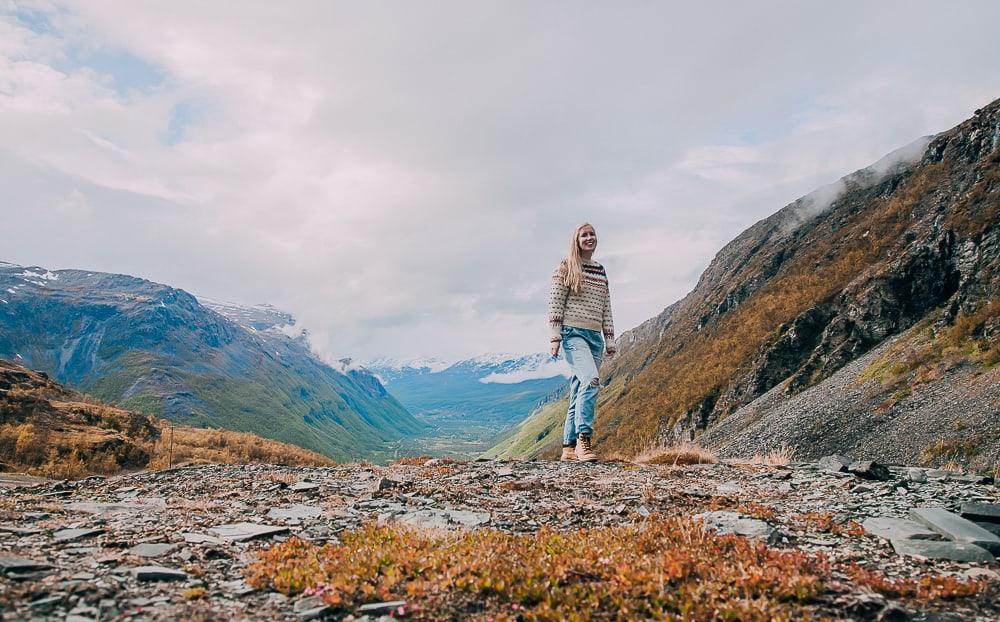
uh, remember what I said about hiking in jeans? do as I say, not as I do!
Not bringing enough water and snacks
While people tend to be good at bringing supplies for longer hikes, I find that a lot of people forget about water and snacks on shorter hikes. Just because it’s cold out doesn’t mean you won’t need lots of water, even if you’re just going out for an hour.
Plus a hike in the Norwegian mountains is the perfect excuse to sample some Norwegian chocolate. The chocolate of choice for most Norwegians on a hike is Kvikk Lunsj, though I tend to go for the classic Freia melkesjokolade. So yum!
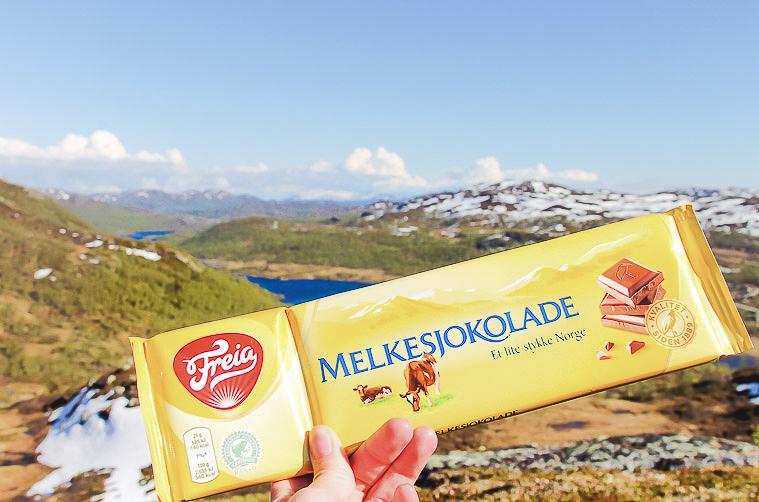
Forgetting sunscreen and sunglasses
Maybe this is just a pale girl talking, but wear sunscreen, even on a cloudy day, because those clouds could be gone in an instant! And the same goes for sunglasses – just because it’s overcast and drizzling doesn’t mean the sun won’t come out soon to blind you.
Not making a packing list
I’m not really one for lists, or any sort of organization in general, but if I’m setting out on a long hike I will make a packing list, because it would be potentially really bad to forget something.
Mine usually includes all of my layers of clothing, water, snacks, map, first aid kit, a hat, and during the months where it gets dark I’ll throw in a flashlight and reflective vest (we don’t go anywhere from autumn to spring without a reflective vest for walking along dark roads!).
Sticking too rigidly to your plan
Plans are great, but you also need to be prepared to adapt them according to the conditions outside and your abilities. Yes, your original plan might have been amazing, but I promise you can still have a great time even if you make some adjustments.
Refusing to turn around when you need to
On that note, there is no shame in turning around! Some hikes can turn out to be much harder than expected, the conditions could be too muddy or snowy to continue, or something else might happen where you’ll need to turn around. And that’s fine! You don’t need to have reached the top of the mountain to have had a wonderful day out hiking.
In fact some of my favorite days hiking in Norway have been when I didn’t actually make it to my destination. Sometimes you’ll find a lovely place to stop for a rest or to lie under the sun, and that’s fine! It’s about the journey, right?
Continuing up when you’re lost
Yes, you might be able to find your way back to the path if you keep going up, but if you really don’t know where you are and are running out of daylight, make your way downhill and try to follow streams or rivers, as they will tend to lead back to a town, or even just a farm.
And if things are getting dire, save your energy and try to make a little shelter. Sit on your backpack so your bum stays dry and keep calm. Plenty of people have spent the night outside when they’ve gotten lost hiking in Norway, and you should be totally fine too, don’t worry.
Leaving trash behind
Okay, I know I don’t really need to tell you this, but I’m going to say it anyway: don’t leave anything behind in the mountains. I’m sure you love how pristine they are, so lets keep them that way.
And that’s it!
If you have any other hiking tips, please share them in the comments!
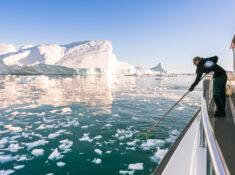

 12 Best Norwegian Desserts (With Recipes!)
12 Best Norwegian Desserts (With Recipes!)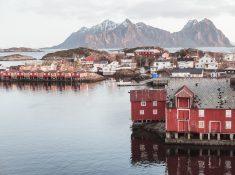
Nynke says
I couldn’t agree more on all of these! And I love that even sunscreen and sunglasses made it onto the list (fellow white girl with a penchant for turning red here! but for everyone else: skin cancer is real…). I remember my hike to Prekestolen when I hadn’t seen the sun in two weeks in Stavanger, and I figured my sunglasses would just be dead weight. The weather turned gorgeous and I had to buy an ugly cap to minimise the glare!
I do have one note to add to rule number one: more and more hikers are starting to wear trail running shoes, which do have the required good-grip soles to be safe in mountainous terrain. But if you want your feet to stay dry and/or if you don’t quite trust your ankles or your ability to always put your feet down right, hiking boots are definitely still the way to go!
Nynke says
Oh, and one more tip: if you’re one of those people who really, really crave some detailed fantasising about the hikes you’ll make on your trip in Norway, and you read some Norwegian or are okay with Google Translate, ut.no has a really extensive database of hikes, with descriptions, mapped routes and a few pictures. Just make sure to look for summer routes, not winter ones, unless you want to end up having to cross lakes and swamps that are easily crossed on skis in winter :).
And of course, Silvia’s advice about locals knowing best still stands!
Ragnhild says
This is definitely useful information for people hiking in Norway — and often for their first time. I wrote my Master’s thesis in Communication Design on ‘measures of using visual information in order to better prepare tourists for the Norwegian mountains’, and therefore reducing the number of mountain rescues. It’s crucial that tourists prepare before they go hiking, but unfortunately a big amount are unaware of the lengt, duration and difficulty of the hike they’re about to embark. I feel sorry for the tourists but even more for the Red Cross volunteers who have to go up in the mountains to rescue them.
Silvia says
Oh interesting! And yeah, I do worry that all the social media photos of crazy viewpoints in Norway encourage people to embark on hikes they’re not at all prepared for.
Anna Makridi says
Great post! Thanks for sharing!
Chloe says
Hi Silvia,
Thanks for this info! I just found your blog and love it!
I’ll be in Finland/Norway this Oct/Nov and am thinking of buying the Ecco hiking boots you’re wearing in the first photo. I do the same as you and love to double up hiking boots with dresses for city wear too. But I’m just wondering if they would be ok as winter/wet boots too for Norway/Finland in Oct/Nov? Many thanks!
Silvia says
I think they’ll be fine for October and November, though if you’ll be somewhere with lots of snow I would buy snow boots instead.
Ingrid says
Hey! Just a tip from a norwegian. There is a Website called ut.no. It’s possible to get it translated to english with google. It has so many hiking routes and information about them. Also pretty easy to use. I use it even in my local area. Maybe it could be helpful for someone
Sofia says
Hi Silvia- I’m traveling to Oslo for work in mid March and want to extend my trip to see more of Norway. I’d love to take advantage of the outdoors but have heard hiking in March is difficult because of the weather. Do you recommend any hikes/outdoor adventures in March? Thanks!
Wice says
Great article to remind everyone about the seriousness of hiking. It can be quite dangerous and there’s really good advice here. I’m going next year and I must say that the though of getting lost or injured is in the back of the mind. Thanks for all the advice – I’ll be sure to get the Norwegian chocolate too as a hiking snack.
ramblenerds says
Beautifully dangerous! Indeed a great way to describe Hiking in Norway.
Never been there hope to visit this county and experience it’s savage beauty.
Thank you for sharing!
Cheers,
Don
Robyn says
I love all the insight you have regarding hiking, including the proper gear to wear. My husband and I haven’t gone on many hikes before but can’t wait to explore Norway!
Are wild animals (wolves, bears, etc.,) ever a problem?
Thank you!
Robyn
Silvia says
I saw a moose on a hike once, but that was it!
Carl R. Brush says
This post was truly worthwhile to read. I wanted to say thank you for the key points you have pointed out as they are enlightening.
Tommy Høyland says
Hi
Very interesting reading for a Norwegian like me😊 You got it all so right. Over and over again I have meet people hiking in jeans, sneakers and hardly any extra clothes or any other supplies. The weather in the mountains can change dramatically within minutes.
One comment about water. We have a saying that if the water flows over 5 stones it is safe. It’s almost true. If you are high up in the mountains and you don’t see a lot of sheep’s or traces of them (look for excrement) it’s normally safe. An exception is if you see a lot of lemmings. They can contaminate the water in the area. I always drink the water and have never been ill. I usually start with 0,5-1 liter and refill in the mountains. But always from running water. Welcome to Norway and happy hiking!
Jpf says
Do you recommend using trekking poles when hiking? It would seem they would be helpful on rugged trails.
Silvia says
I don’t personally use poles, but I know some people love to use them!